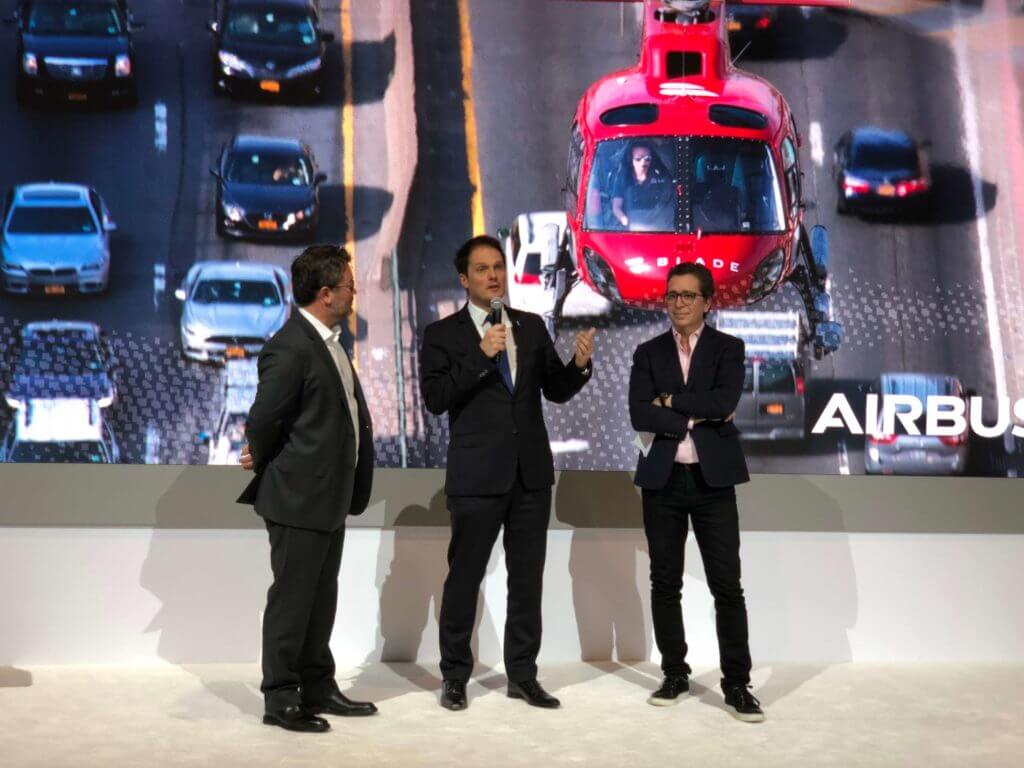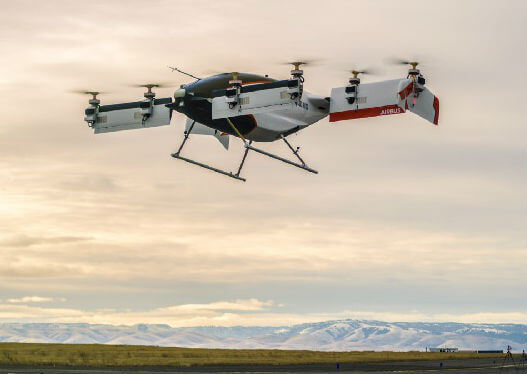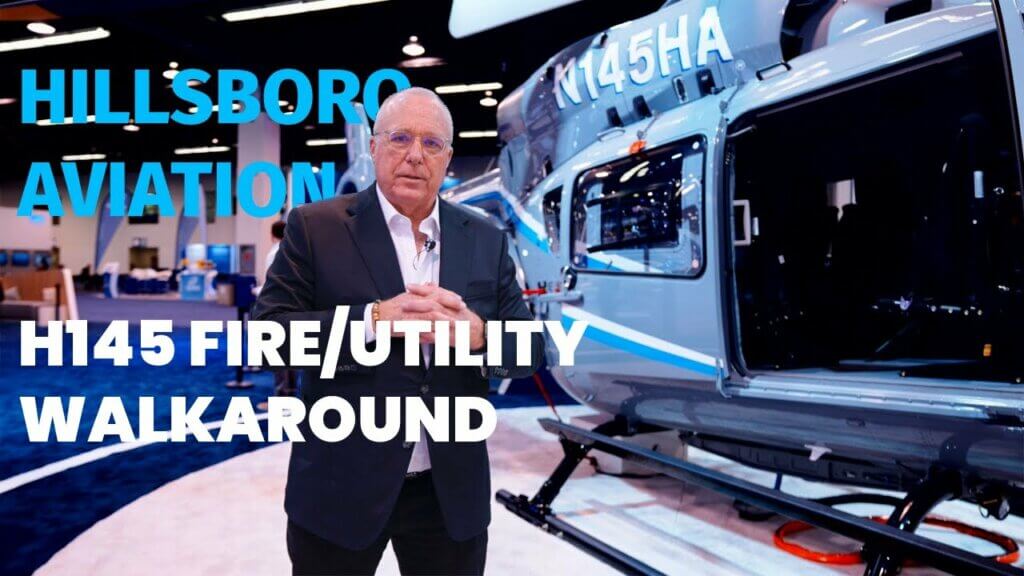At its Elevate Summit last year, the ride-sharing company Uber presented its vision for a future in which fleets of electrically powered vertical takeoff and landing (eVTOL) aircraft shuttle passengers above major metropolitan areas at a cost comparable to traveling by ground.
That vision was a topic of much conversation at HAI Heli-Expo 2018, with some attendees embracing an eVTOL future, and others skeptical that it will come about anytime soon.

For at least two companies, however, eVTOL aircraft aren’t a prerequisite for revolutionizing urban air mobility. Through a strategic partnership announced at Heli-Expo on Feb. 28, Airbus Helicopters and Fly Blade, Inc. aim to make it easier and cheaper for the public to find helicopter seats on demand, as the companies simultaneously lay the groundwork for a future in which eVTOL solutions expand the market for urban air transportation.
“We’re not waiting for eVTOL. We’re not. We’re doing this today,” Blade CEO Rob Wiesenthal told reporters at Heli-Expo in Las Vegas, Nevada, last week.
Airbus Helicopters, Inc. president Chris Emerson echoed, “What is really exciting about this [is] today we can create a customer experience just by pooling demand, and bringing the cost lower than pure charter on existing aircraft. That’s getting people to fly now.”
Since launching in New York City in 2014, Blade has proven that there’s a viable market for on-demand helicopter transportation in urban areas. Blade customers use the company’s mobile app to reserve either an entire helicopter or seats on scheduled flights along popular routes: for example, from Manhattan to the Hamptons, Atlantic City, or local airports.
Blade has recently expanded into on-demand jet charter and new geographic markets, including Los Angeles. The company does not operate aircraft itself, leaving that to established, Federal Aviation Administration-certified air taxi operators. Instead, it uses its digital technologies to pool demand, then manages the customer experience with stylish lounges that are a step up from the average fixed-base operator’s waiting room.
“Our goal is to help build demand on behalf of the operators, and provide a convenient, cost-effective service to our consumers,” Wiesenthal explained. “And we’ve proven that since Blade has started in the New York area, the market for by-the-seat and charter has gone up by over 40 percent.
“Seventy-five percent of all Blade flyers have never been in a helicopter,” he continued. “So what that means is that each of our operators have actually expanded their markets — we’ve created another revenue stream for them.”
Airbus has its own on-demand helicopter booking platform, Voom, which it launched last year in São Paulo, Brazil, and will soon be expanding to Mexico City. The manufacturer also has an event-based helicopter shuttle service in the Dallas-Fort Worth, Texas, area called Airbus Ride.
The partnership agreement with Blade will give Airbus access to Blade’s expertise in comprehensive booking and operator technology platforms, while helping Blade accelerate its expansion into new markets. At the same time, it will position both companies to take advantage of the boom in urban air transport that could come about with eVTOL technologies.
“There’s an entire stack of what we’re working on with Airbus and our operators that is completely relevant to eVTOL,” said Wiesenthal, citing consumer messaging and interfaces; operator dashboard and accounting software; and on-the-ground logistics management. The many thousands of passenger movements envisioned for eVTOL networks will require sophisticated coordination behind the scenes, which is something that Blade is already doing well.
“We can have 350 missions in a 24-hour period on one heliport,” said Wiesenthal. “That requires a lot of movement and a lot of coordination.”
For eVTOL platforms to be used even more intensively in urban areas, they’ll need to be quieter and more cost-effective than the helicopters that exist today. According to AHS International executive director Mike Hirschberg, who presented on eVTOLs at Heli-Expo, these requirements are feasible thanks to advancements in electric motors, batteries, and manufacturing technologies.

As Hirschberg explained, eVTOLs won’t be electric helicopters any more than cars were buggies with mechanical horses. Instead, new configurations will take advantage of distributed electric propulsion to replace today’s complex drive systems, reducing manufacturing and operating costs. Airbus is already active in developing such platforms, including the four-passenger City Airbus eVTOL demonstrator and the single-passenger Vahana eVTOL aircraft, both of which are autonomously piloted.
In addition to being cheaper to build and fly, eVTOL aircraft should also be inherently quieter than existing helicopters — which will be key to gaining community support for widespread deployment.
“When you think about eVTOL, and some of the numbers that we’ve seen where we talk about silence in the air, and 70 or 75 decibels on takeoff and landing, that’s really exciting,” Wiesenthal said. “Because at that point, you can reintroduce the conversation of having landing zones at places you never thought were possible.”
As promising as an eVTOL future sounds, however, neither Blade nor Airbus expects it to arrive overnight. Even when eVTOLs do arrive, Wiesenthal said he anticipates a “co-habitation phase, where over time, you’ll see a mix of eVTOL and helicopters. The longer missions will be done with the helicopters, the shorter missions will be done probably by eVTOL-like equipment.”
In the meantime, data obtained through its partnership with Blade will help Airbus understand how to design eVTOL aircraft to meet demand.
“To find the right eVTOL, we need to understand what the demographics, what the requirements are going to be,” said Emerson. “We don’t yet know, is it going to be four people going 10 minutes? Is it two, 30 minutes?” Emerson characterized the move to eVTOL as a crawl-walk-run progression, and said that the industry is currently at “a crawling phase of understanding, what is this market going to look like in the future?”
While Airbus and Blade have praised each other as partners working toward a common goal, their agreement isn’t exclusive. Wiesenthal said that Airbus is fully aware that Blade’s operator partners fly helicopters from a number of different manufacturers — and Airbus is OK with that.
“What [Airbus is] interested in is growing this industry along with us, and they’re fantastic partners to help us grow this industry,” he said.
According to Matthieu Louvot, executive vice president of customer support and services for Airbus Helicopters, the company believes it’s well positioned to benefit from any expansion of the industry, even without an exclusive agreement.
“It’s helping the operators have more business, more flight hours, and it can grow the whole helicopter market,” he said. “Anything that grows the helicopter market is good [for Airbus].”










They need lower maintenance and less noise.
Yes. That’s the plan! Far less maintenance and far less noise.
what will be the effective distance and velocity for these kind of vehicles?
will the electric batteries support these vehicles within 10 yesrs?
Is there a place for an intermidiate Hybrid solutions in the next 10-15 years ?